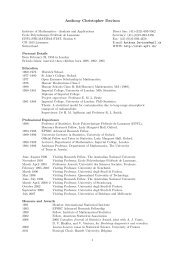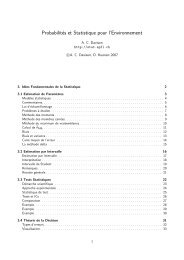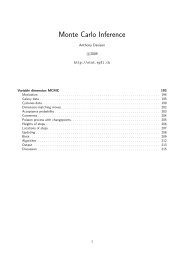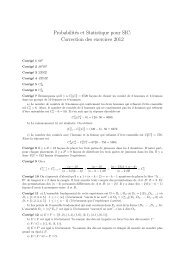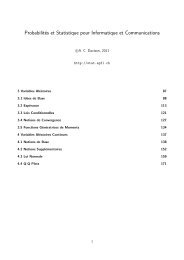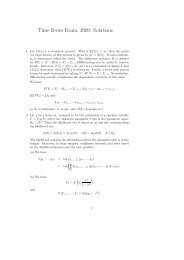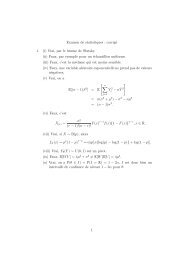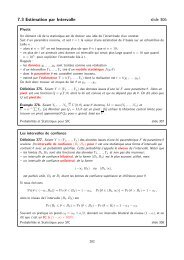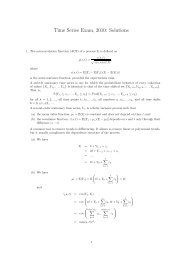Time Series - STAT - EPFL
Time Series - STAT - EPFL
Time Series - STAT - EPFL
You also want an ePaper? Increase the reach of your titles
YUMPU automatically turns print PDFs into web optimized ePapers that Google loves.
ARMA models<br />
Definition 42 A time series {Y t } is an autoregressive-moving average process of order p,q,<br />
ARMA(p,q), model, if it is stationary and of the form<br />
Y t = φ 1 Y t−1 + φ 2 Y t−2 + · · · + φ p Y t−p + ε t + θ 1 ε t−1 + · · · + θ q ε t−q , (12)<br />
where φ 1 ,...,φ p ,θ 1 ,... ,θ q are constants with φ p ,θ q ≠ 0. Unless otherwise mentioned, we assume<br />
iid<br />
that ε t ∼ N(0,σ 2 ). A process with non-zero mean is obtained by replacing the Y s in (12) by Y t − µ,<br />
etc.<br />
□ We use the autoregressive and moving average operators to write (12) as<br />
φ(B)Y t = θ(B)ε t .<br />
The properties of the process are intimately tied to the polynomials φ(z),θ(z), where we take<br />
z ∈ C. Let D = {z ∈ C : |z| ≤ 1} denote the unit disk in the complex plane.<br />
□ We remove common factors from φ(B) and θ(B) to eliminate overparametrisation, also called<br />
parameter redundancy.<br />
<strong>Time</strong> <strong>Series</strong> Spring 2010 – slide 141<br />
Causality, invertibility<br />
Definition 43 An ARMA(p,q) process φ(B)Y t = θ(B)ε t is causal if it can be written as a linear<br />
process<br />
∞∑<br />
Y t = ψ j ε t−j = ψ(B)ε t ,<br />
where ∑ |ψ j | < ∞, and we set ψ 0 = 1. It is invertible if it can be written as<br />
where ∑ |π j | < ∞, and we set π 0 = 1,<br />
ε t =<br />
j=0<br />
∞∑<br />
π j Y t−j = π(B)Y t ,<br />
j=0<br />
Theorem 44 (a) An ARMA(p,q) process φ(B)Y t = θ(B)ε t is causal iff φ(z) ≠ 0 within D. If so,<br />
then the coefficients of ψ(z) satisfy ψ(z) = θ(z)/φ(z) for z ∈ D.<br />
(b) The process is invertible iff θ(z) ≠ 0 for z ∈ D. If so, then the coefficients of π(z) satisfy<br />
π(z) = φ(z)/θ(z) for for z ∈ D.<br />
Thus the process is causal iff the roots of φ(z) lie outside D, and invertible iff the roots of θ(z) lie<br />
outside D.<br />
<strong>Time</strong> <strong>Series</strong> Spring 2010 – slide 142<br />
Example<br />
Example 45 Investigate the properties of the process<br />
Y t = 0.4Y t−1 + 0.45Y t−2 + ε t + ε t−1 + 0.25ε t−2 .<br />
<strong>Time</strong> <strong>Series</strong> Spring 2010 – slide 143<br />
133



